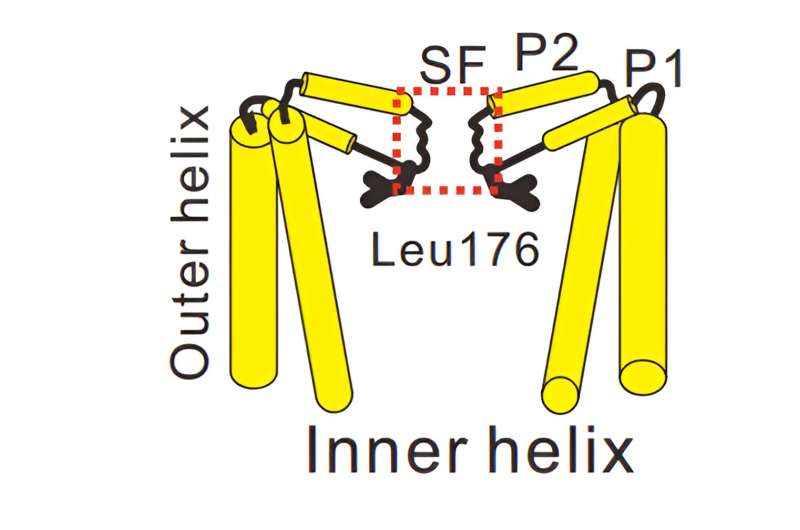This article has been reviewed according to Science X's editorial process and policies. Editors have highlighted the following attributes while ensuring the content's credibility:
fact-checked
peer-reviewed publication
trusted source
proofread
Researchers show how calcium ions can block sodium ion channels in cell membranes

Ion channels are structures within cell membranes that enable specific ions to travel to and from the cell. Such transfer is essential for a variety of physiological processes such as muscle cell contraction and nerve excitation. In so-called tetrameric cation channels, the ion selectivity results from the unique structural and chemical environment of the part referred to as the selectivity filter, which is located between two intertwined helical structures.
Tetrameric ion channels are prone to "divalent cation block," the blocking of the channel by ions such as calcium (Ca<2+). Such blocking disrupts the channel's functioning, which in turn can cause cellular malfunction. How exactly divalent cation block happens is still unclear at the moment—particularly, a direct observation of the cation actually blocking the ion pathway has not been reported yet.
Now, Takashi Sumikama from Kanazawa University in collaboration with Katsumasa Irie from Wakayama Medical University and colleagues have discovered the mechanism behind divalent cation block in NavAb, a well-known tetrameric sodium (Na) channel. Through structural analysis and computer simulations, the researchers were able to reveal the relevant structural features and molecular processes at play. They have reported their findings in Nature Communications.
NavAb is a sodium channel cloned from a bacterium (Arcobacter butzleri) and has a well-known structure. Sumikama and Irie's colleagues performed experiments with NavAb and three mutants. The structures of the mutants were determined for environments with and without calcium. The scientists focused on the differences in electron densities for the different structures, as these provide insights into the locations of the calcium ions.
They found that for the mutants displaying calcium blocking, one or two calcium ions are located at the bottom of the selectivity filter. They also discovered that magnesium (Mg2+) and strontium (Sr2+) ions, two other divalent cations, blocked the calcium-blocking mutant sodium channels.
The researchers then performed computer simulations to obtain a detailed understanding of the interaction between the calcium ions and the mutated NavAb channels. The simulations reproduce the dynamics of ions passing—or not passing—the channel. In the absence of calcium ions, sodium ions were observed to penetrate the channel.
In the presence of calcium ions, penetration significantly decreased in the calcium-blocking mutants. The simulations also confirmed that the blocking calcium ions are "stuck" at the bottom of the selectivity filter, and revealed that this "sticking" is related to the increased hydrophilicity (affinity to water) of relevant structural parts of the mutated channels.
The results of Sumikama and Irie's colleagues provide an important step forward towards a full understanding of the mechanism of divalent cation block in NavAb, an important and representative sodium ion channel. Quoting the scientists, "Our results and methods of structural analysis and molecular dynamics simulations are … expected to play an active and meaningful role in the advanced analysis of divalent cation-blocking mechanism."
More information: Katsumasa Irie et al, The structural basis of divalent cation block in a tetrameric prokaryotic sodium channel, Nature Communications (2023). DOI: 10.1038/s41467-023-39987-0
Journal information: Nature Communications
Provided by Kanazawa University




















